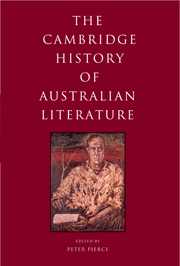Book contents
- Frontmatter
- Introduction
- FROM EUROPEAN IMAGININGS OF AUSTRALIA TO THE END OF THE COLONIAL PERIOD
- FROM THE LATE NINETEENTH CENTURY TO 1950
- 7 Australia’s Australia
- 8 The short story, 1890s to 1950
- 9 Australian drama, 1850–1950
- 10 ‘New words come tripping slowly’: Poetry, popular culture and modernity, 1890–1950
- 11 Australian fiction and the world republic of letters, 1890–1950
- 12 Australia’s England, 1880–1950
- TRAVERSES
- FROM 1950 TO NEARLY NOW
- Select bibliography
- Index
- References
8 - The short story, 1890s to 1950
from FROM THE LATE NINETEENTH CENTURY TO 1950
Published online by Cambridge University Press: 28 May 2011
- Frontmatter
- Introduction
- FROM EUROPEAN IMAGININGS OF AUSTRALIA TO THE END OF THE COLONIAL PERIOD
- FROM THE LATE NINETEENTH CENTURY TO 1950
- 7 Australia’s Australia
- 8 The short story, 1890s to 1950
- 9 Australian drama, 1850–1950
- 10 ‘New words come tripping slowly’: Poetry, popular culture and modernity, 1890–1950
- 11 Australian fiction and the world republic of letters, 1890–1950
- 12 Australia’s England, 1880–1950
- TRAVERSES
- FROM 1950 TO NEARLY NOW
- Select bibliography
- Index
- References
Summary
Short stories are written by individuals but they are influenced by other writers, critics and publishers. More than other literary genres, short stories are dependent on newspapers and magazines or anthologies for first publication. The literary activity of short story writers may therefore be represented as an individual struggling for self-expression, but a more comprehensive and realistic view includes writers, editors, publishers and readers in a continual process of interaction – each adjusting or readjusting their role in relation to the others’ needs and requirements. This interactive process may affect the length of stories, whether they entertain or instruct, and their shape or form.
This chapter will give most attention to individual short story writers and collections of their work from the 1890s to about 1950 in their literary, geographic and historical contexts. Special attention will also be given to newspapers and periodical publications as well as books, and responses to them by readers and critics. Questions of evaluation arise. For instance, can any Australian writer of short stories between the 1890s and 1950 be called ‘great’? A combination of favourable critical responses, contemporary popularity and sustained attention by publishers over time would place Henry Lawson in this category. But what does such categorisation mean? In particular, how are such qualitative judgments to be distinguished from commercial considerations? An example is the case of Steele Rudd, whose successful marketing and transmutations of his Dad and Dave stories into plays and films extended his reach beyond Lawson’s.
- Type
- Chapter
- Information
- The Cambridge History of Australian Literature , pp. 156 - 179Publisher: Cambridge University PressPrint publication year: 2009
References
- 3
- Cited by

